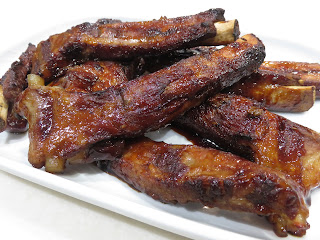When I was a child, we pretty much had Chinese food all the time, apart from school lunches. This was due to my 婆婆 (my mum's mum) living with us, who did the cooking in the house. So we would always have a hot meal for lunch and dinner, rice with a selection of dishes. There would always be vegetables and often steamed fish, which I hated and thought of as bony and slimy. I remember her sitting in our lounge with a chopping board at her feet and a cleaver in each hand, mincing meat as we chatted or watched TV. There would also always be leftovers from the previous meal. As children, one of our favourites was when 婆婆 would fry slices of pork luncheon meat (午餐肉), and also open a can of pineapple chunks - that salty and sweet combination with the rice was always a winner.
We used to get incredibly excited when we had non-Chinese food, as it was a rare occasion. The 婆婆 referred to in the title of this post is actually my mum, so my children's 婆婆. I remember when she used to make us "spaghetti bolognese", as a special treat. It doesn't have much in common at all with a bolognese sauce as we might know it, but it is sweet and comforting. Tonight I recreated it for my family and it brought back a real feeling of nostalgia. I have adapted it a little, mainly because I had four tomatoes to use up. My children cleared their plates and the middle child asked if I could make it more "authentically" next time, using just tomato ketchup and no fresh tomatoes! I'll definitely do this, next time I make it - just follow the recipe, omit the tomatoes and add more ketchup and water if needed.
Ingredients
- 4 large, ripe tomatoes
- 250-300ml tomato ketchup
- 350g pork mince
- 1 medium onion, diced
- 1 bowl of frozen petits pois
- 2 shakes of worcester sauce
- 2 shakes of light soy sauce
- 2 cloves of garlic, peeled and bashed with the flat of a cleaver
- 2 slices of raw ginger, peeled and bashed with the flat of a cleaver
- A pinch of ground white pepper
- 1 tsp sugar (optional)
- 2 tbsp sunflower oil for frying
- A dash of sesame oil
- Water to thin sauce if necessary
- Salt to taste (optional)
- 300-350g dried spaghetti
Serves 5 - 7
Instructions
- Cut a cross into the bottom of each tomato and cover with boiling water. Leave for 10 minutes, then drain and cool. Peel the tomatoes, then de-seed and dice finely.
- Heat 2 tbsp of oil in a wok, then add the garlic and ginger. Stir-fry quickly, taking care not to burn
- Add the diced onion, increase the heat and stir-fry for a few minutes, until the onion has softened. Add the minced pork and brown it until it is all sealed
- Add the worcester sauce, soy sauce and white pepper and mix it in thoroughly. Add the diced tomato and stir-fry for a few minutes. You can remove the garlic and ginger after this stage if you like
- Add the tomato sauce to the wok and mix thoroughly. Add a little water to thin the mixture if necessary. Bring to the boil, then cover and simmer for 35-45 minutes, or until the onion has softened. Add sugar if you wish the sauce to be sweeter.
- Bring a large pan of salted water to the boil and cook the spaghetti according to the packet instructions
- When the spaghetti has 5 minutes to go, add the petits pois to the wok of sauce. Stir the sauce and simmer it for the remaining 5 minutes
- Drain the spaghetti when it is cooked, then add it to the wok. Reduce the heat to very low, then add a little sesame oil. Mix the pasta and the sauce thoroughly in the wok. Add salt to taste if you like, at this stage
- Serve in warmed dishes

婆婆's "Spaghetti Bolognese"







